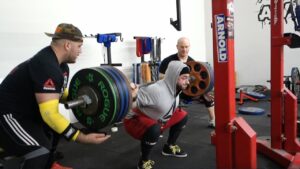Physical strength is a fundamental component of overall health and well-being. It allows you to perform daily activities with ease, improves balance and coordination, reduces the risk of injuries, and even boosts metabolism. Whether you’re a seasoned athlete or just starting your fitness journey, increasing your physical strength is a worthy goal.
Your journey to getting seriously strong starts here.
You’ve decided that you want to get strong. That’s great. Increasing strength will help you avoid looking like you’re drowning in your sweater, sure, but your health will improve, too. A study in Current Sports Medicine Reports shows that strength training may improve your cardiovascular health, lower your blood pressure, and ease back pain. You’ll also lose body fat, gain muscle, think sharper, and be more confident.
Here, we delve into research-backed tips to help you achieve it:
Understanding Strength Training:
Strength training, also known as resistance training, involves working your muscles against a force that causes them to contract. This force can come from weights, free weights, resistance bands, your own bodyweight, or even water. When you strength train, your muscles adapt by becoming stronger and more resilient. This adaptation is a complex process, but research suggests two key mechanisms:
- Myofibrillar Hypertrophy: This refers to an increase in the size of the individual muscle fibers. Studies like one published in the “Journal of Strength and Conditioning Research” have shown that progressive overload, where you gradually increase the weight or difficulty of your exercises over time, is crucial for stimulating myofibrillar hypertrophy.
- Neural Adaptations: Strength training also improves the communication between your brain and muscles. Research published in “Experimental Physiology” suggests that your nervous system becomes more efficient at recruiting and activating muscle fibers, leading to greater strength gains.
But before you load up that barbell and start clanging and banging, you’ve got some reading to do. Getting strong is a marathon, not a sprint (but don’t worry, you won’t actually have to run). To gain strength steadily and safely, you need to have a plan along with the tools and know-how to execute it. In other words: you need to strengthen your mind as you strengthen your body. Here are the steps you need to take to increase your strength:
-
How Getting Strong Works
Physiologically speaking, gaining strength is quite simple: You apply external stress to your body (in the form of a loaded barbell, a dumbbell, a kettlebell, or a set of bands), and it responds by recovering and adapting to that stress. Essentially, you’re telling your body, “Hey, body, I need you to lift this weight, so get with the program.” Because your body is an incredible machine, it will respond with, “Sure thing, boss, now I’m ready for more.”

 The next time you train, you’ll apply slightly more stress. This can be in the form of more weight or more reps (we’ll get to that later).
The next time you train, you’ll apply slightly more stress. This can be in the form of more weight or more reps (we’ll get to that later).
Strength positively impacts your body in many ways, and a lot of them have nothing to do with the squat rack. For one, stronger muscles can better stabilize the joints they surround, so you’ll be able to move more easily and efficiently.
Most of the movements you’ll perform to build strength are loaded versions of movement patterns you engage in daily. Remove the barbell from your traps, and the back squat is the same motion you use to get on and off the toilet. Opening a car door is a similar motion to a standing cable row. Is this to say that you need a big one-rep max back squat or to bang out reps of cable rows to use the toilet and open your car door — no.
However, adults are known to lose between three and eight percent of their muscle mass every decade. Getting stronger in the gym will ensure that you retain more muscle as you age.
-
Strength Training and Your Nervous System
Strength doesn’t start with your muscles but with your nervous system. The nervous system comprises the central nervous system (CNS) and the peripheral nervous system (PNS). The CNS consists of the brain and spinal cord working in tandem while the PNS is made up of nerves that stem from your spinal cord and extend throughout your body. Both of these systems control all five of your senses, along with your ability to move and balance (as well as temperature control, sleep, and other vital functions).

 When you squat a barbell (or perform any lift for that matter), the movement starts in your brain. The cerebral cortex fires off a signal that travels down your spinal cord and contracts the muscles necessary to perform the movement. That’s your nervous system working. When you lift, you’re teaching your nervous system to contract the right muscles in the right order at the right time to complete a specific task.
When you squat a barbell (or perform any lift for that matter), the movement starts in your brain. The cerebral cortex fires off a signal that travels down your spinal cord and contracts the muscles necessary to perform the movement. That’s your nervous system working. When you lift, you’re teaching your nervous system to contract the right muscles in the right order at the right time to complete a specific task.
On your first day of performing a new movement, the muscles and nervous system will have to get better acquainted. Over time, the nervous system will respond by granting you quicker and more powerful muscle contractions. And those swifter contractions allow you to lift more weight. As your nervous system gets used to the movement, you’ll also become more coordinated. That movement-specific coordination, which is achieved by your motor cortex figuring out the best way to fire the muscles, will let you perform the movement more efficiently.
Your nervous system responds to strength training before your muscles, according to science. A study in the Journal of Neuroscience saw two macaque monkeys lift weights and monitored the effects of weight training on their nerves. The monkeys performed one-arm pulls with a single arm. After three months, the researchers concluded that “strength training is associated with neural adaptions.” It was the monkey’s nerves and their muscle-brain connection that was strengthened before their muscles.
But this doesn’t mean your muscles aren’t working. After all, they’re still under load. Hypertrophy is a generally slower process compared to neural adaptions, as well, which is why it’s easier to point to the nervous system as the first system to adapt. Also, in the study above, scientists focused solely on the monkey’s neural response. So, while the results are still interesting and noteworthy, you shouldn’t discount the effects of strength training on your muscles. Though, hypertrophy from strength training is more a side effect as opposed to direct response.
Another study performed on actual humans shows that lifting with both heavy and light weights (80% and 30% of one’s one-rep max in this case) resulted in more muscle mass. However, it was the heavy training group that significantly increased their one-rep max. The study authors suggest strength gains may be due at least in part to neural adaptions, not just muscular ones.
-
How to Create a Strength Program
The next step in your strength training journey is to create a program. The best program will include a mode of progression, specific exercises, and utilize the right sets and reps. Here’s a break down of each element you need to build your very own strength training program.
-
Choose a Workout Split
A workout split dictates how you divvy up your training each week. You can split up your training by muscle groups, by specific lifts, or movement type.

 Bodypart splits have you focus on anywhere from one to three muscle groups per training session. Bodybuilders usually like this option since it allows them to target specific muscles with more volume than workout split options that engage more of the body. You can get strong following a body part split, but it may not be your best option.
Bodypart splits have you focus on anywhere from one to three muscle groups per training session. Bodybuilders usually like this option since it allows them to target specific muscles with more volume than workout split options that engage more of the body. You can get strong following a body part split, but it may not be your best option.
Typically, strength workouts revolve around some variation of the big three lifts: the deadlift, back squat, and bench press. These three exercises are compound movements. This means that they engage more than one joint and, therefore, a large number of muscles. You can also typically lift more weight with compound movements than, say, biceps and triceps exercises.
For that reason, many strength programs will have you perform a bench press day, a squat day, and a deadlift day. This pairing is also known as a push, pull, legs workout split. After the main movement, you’ll perform accessory exercises that will help strengthen the muscles involved in your main lift. For example, your triceps and shoulders are key players in the bench press, so it makes sense to perform a few sets of two exercises for each later in the workout.
Check Out Our List Of The Best Supplements For Building Muscle, Shredding Muscle, Recovery, And Great Health, and Wellness Products! Purchase ifbnewsfeed.org‘s apparels Here: ifbnewsfeed.org
All that said, start with a plan that looks like this:
Monday: Bench Press (Push)
Tuesday: Rest
Wednesday: Deadlift (Pull)
Thursday: Rest
Friday: Squat (Legs)
Saturday: Rest
Sunday: Rest
-
Select the Right Exercises
You can train with any exercise to get strong, but there’s definitely a pecking order. As we mentioned above, the bench press, deadlift, and back squat are the three movements you should aim to get the strongest in. When you boil these three exercises down to their mechanics, you get a horizontal press, a hip hinge, and a squat. If you plan to compete in a powerlifting meet, you need to train in the big three as those are the lifts you do in a meet.

 If you’re looking to get strong, feel free to sub in a variation of the above movements. Instead of a barbell back squat, squat with a safety bar or perform front squats. Barbell deadlifts aren’t right for everyone, either, so use a trap bar. Choose a variation and stick with it for a bit.
If you’re looking to get strong, feel free to sub in a variation of the above movements. Instead of a barbell back squat, squat with a safety bar or perform front squats. Barbell deadlifts aren’t right for everyone, either, so use a trap bar. Choose a variation and stick with it for a bit.
Performing just the bench, squat, and deadlift isn’t enough to stimulate all of the muscles. To get stronger, you need to tax the other muscles that assist in the main lifts, too. Ensure that you’re performing exercises that correspond to the correct day of your training splits. That means performing pushing movements on push days, pulling exercises on deadlift days, and leg moves on a squat day. Simple, right?
Accessory exercises should also primarily be compound, or multi-joint, exercises, simply because they offer more for your strength-building buck. Why do chest flyes on a cable machine when dips work the chest, shoulders, and triceps? You want as little fluff as possible in your program. That’s not to say single-joint, or isolation moves, can’t make an appearance in a program, but use them in moderation.
We won’t leave you to guess which exercises to do when (that’d be kind of a jerk move). Here’s a menu of accessory exercises to tack onto each of your training days. In addition to the primary movement, pick three to four exercises from each list and one core movement to add to each training day. Swap out these moves for new ones every eight to 12 weeks to keep your programming fresh.
Push Day
- Dumbbell Bench Press (flat, incline, or decline)
- Push-Up (weighted or bodyweight)
- Chest Dip
- Military Press (using dumbbells or a barbell)
- Dumbbell Skull Crusher
- EZ-bar Skull Crusher
- Suspension Trainer Triceps Extension
- Overhead Dumbbell Extension
Pull Day
- Barbell Row
- Single-arm Dumbbell Row
- Chin-Up or Pull-Up
- Lat Pulldown
- Seated Cable Row
- Pendlay Row
- Hammer Curl
- Incline Dumbbell Curl
- Barbell Curl
Leg Day
- Goblet Squat
- Leg Press
- Lunge
- Zercher Squat
- Split Squat
- Lying Leg Curl
- Romanian Deadlift
- Glute-Ham Raise
Core
- Plank
- Sit-Up
- Side Plank
- Ab Wheel Rollout
- Glute-Ham Raise Sit-Up
- V-Up
-
Plan Your Sets and Reps
By now, you should know what you’re going to train when and the exercises you plan on using. Now the big question is: How many sets and reps to do for each exercise?

 There’s an inverse relationship between how many reps you perform and the amount of weight you’re lifting. Meaning, the heavier the weight you’re lifting is, the fewer reps you’ll perform. Four to six reps per set is typically an effective rep range for lifters looking to get strong. The weight is heavy enough that you’ll elicit a strong muscular response, but it’s lighter than a one-rep max attempt. The risk of injury is lower, and you’re able to maintain proper form.
There’s an inverse relationship between how many reps you perform and the amount of weight you’re lifting. Meaning, the heavier the weight you’re lifting is, the fewer reps you’ll perform. Four to six reps per set is typically an effective rep range for lifters looking to get strong. The weight is heavy enough that you’ll elicit a strong muscular response, but it’s lighter than a one-rep max attempt. The risk of injury is lower, and you’re able to maintain proper form.
Perform more reps for accessory lifts. For one, you’ll accumulate more volume, which equates to more growth — and a bigger muscle is a stronger muscle as it can handle more weight. Secondly, your joints will thank you for lifting slightly less weight for more reps. We suggest working in the eight to 12 reps for compound accessory lifts and between 12 to 15 reps for single-joint moves like curls and skull crushers.
-
Implement a Mode of Progression
You can’t lift the same weight for the same amount of reps each week and expect to see strength gains. Remember, the body swiftly adapts to stress, and so you need to keep adding stress (meaning more weight or more reps) to force it to re-adapt. This is why implementing a mode of progression is vital.

 The easiest way to get stronger workout to workout is by progressively overloading your reps. For each exercise, start on the low end of a rep range. Start by performing four reps with the most weight you can handle for your primary strength movement. The same goes for accessory movements. Lift the most amount of weight possible for eight reps. During your next workout, add one rep to both your main movement and accessory exercises. Repeat this for four weeks. Then, add a small amount of weight to each lift — even two and a half or five pounds will work — and start the process over again.
The easiest way to get stronger workout to workout is by progressively overloading your reps. For each exercise, start on the low end of a rep range. Start by performing four reps with the most weight you can handle for your primary strength movement. The same goes for accessory movements. Lift the most amount of weight possible for eight reps. During your next workout, add one rep to both your main movement and accessory exercises. Repeat this for four weeks. Then, add a small amount of weight to each lift — even two and a half or five pounds will work — and start the process over again.
A five-pound increase may not sound like much, but bench-pressing four sets of seven reps with 135 pounds versus four sets of seven reps with 140 pounds equals 140 extra pounds pressed in total. That’s a small increase but one that will compound over time to yield some serious strength results. If you add five pounds to your 135-pound bench press every month, then in a year, you’ll be pressing 195 pounds. That’s a formidable jump.
-
How to Test Your Strength
You’ve been following a program and adding weight to the bar for a few months — and now you want to taste the fruits of your labor. We’re talking about setting a new PR (personal record). A one-rep max test is the most traditional test of strength. You increase the bar’s weight incrementally, set after set until you work up to the heaviest amount of weight you can manage for a single rep.
A one-rep max test, however, may not be the best option. Powerlifters and strongmen need to know their absolute max capacity as those competitions call for one-rep max lifts. However, multiple rep maxes — which test a lifter’s ability to lift the most amount of weight possible for typically three or five reps — are just as effective. Since the weights aren’t as heavy, one’s chance of getting injured or experiencing a gym mishap isn’t as likely.
Another way to test yourself is to lift a set amount of weight for as many reps as possible. If you can deadlift 315 pounds for five reps, a good goal would be to deadlift it for 10 reps. Even professional strength athletes such as Rauno Heinla test their max deadlift for reps.
-
Get Strong Without Weights
You read that right. You can get strong without using tools like barbells, dumbbells, and kettlebells. By adjusting your training split and tinkering with your mode of progression, you can increase (and test) your strength with nothing but your body weight. But first, you need to manage your expectations a little. You can’t expect to bang out sets of air squats and lunges and then hit a 500-pound back squat. That said, you can work up to 30 pull-ups (which is also very impressive). Here are a few steps to take to build strength sans weights.


-
Focus on Reps
You can easily measure your progress with bodyweight exercises with reps. An easy way to get started is to see how many reps you can do for certain bodyweight exercises, such as pull-ups, push-ups, and split squats, and then set a goal for how many you want to get. If you can do five pull-ups, maybe aim to get 10. If you can do 20 push-ups, strive for 35 or 40. Set realistic but incremental rep-based goals.
-
Get on a Program
Is this advice starting to sound familiar? Just because you’re bodyweight training doesn’t mean the core principles of getting stronger change. There are bodyweight programs that intelligently assign a set number of reps each day. The idea behind most of these programs is to add a small number of reps each week. Performing as many reps as possible each training session will lead to burnout. Similar to how we suggest adding one rep per strength workout and five pounds to the bar every four weeks, small gains will yield big results over time. Check out our pull-up program and push-up program as a starting point.
Bodyweight training is less taxing than weight training, so you can work the entire body in one session. Feel free to pick a program for a few primary bodyweight moves (again, we like pull-ups, push-ups, and squats) and train them together. Or, follow the push, pull, legs split mentioned above. As for accessory work, there are plenty of bodyweight exercise variations. Here, check out this push-up variation video below to get an idea:
Here’s what a week’s worth of training could look like on a bodyweight version of the push, pull, legs split:
Push Day
Push-Ups: Stick to the sets and reps in the program.
Plyometric Push-Up: five sets of three reps.
Pike Push-Up: three sets of eight reps.
Spider Push-Up: two sets of six reps (each side).
Decline Push-Up: one set to failure.
Pull Day
Pull-Up: Stick to the sets and reps in the program.
Isometric Pull-Up Hold: four sets of as long as possible.
Eccentric Pull-Up: three sets of three reps, taking five seconds to lower yourself (jump back up to the top after every rep).
Inverted Row: three sets of 12 reps.
Leg Day
Bodyweight Squat: Stick to the sets and reps in the program.
Reverse Lunge: three sets of eight reps (each leg).
Rear-Foot Elevated Split Squat: three sets of eight reps (each leg)
Hamstring Slides: three sets of 12 reps.
Use Tempo Training
Manipulating the speed at which you perform an exercise can make it move significantly harder. This is the idea behind tempo training. You probably perform the down portion of a push-up in about one second. Try doing it in three. You just increased your muscle’s time under tension threefold without adding a single pound to your back. Increasing the time it takes to complete an exercise by even one second each week is can improve your strength.
You can also add a pause at the bottom of a squat or push-up or increase the time it takes to raise yourself back up. For example, lower yourself to a count of three, pause for a count of three, and then raise yourself to a count of three. This would be very hard. If you’re new to tempo training, we suggest focusing on one portion of the exercise at a time — so either the lowering phase, lifting phase, or the pause at the top or bottom.
You’ll have to adjust the rep count for tempo training to work. If can do five sets of 10 push-ups comfortably at a regular pace, try lowering yourself to a count of three seconds for five sets of five reps. Then, next week add one second to each rep. Then another second the week after that. From there, continue to add another second. Or can drop the tempo back down to three seconds, add a rep, and start the process over. This formula applies to most bodyweight exercises.
How to Proceed
Now, it’s time to leave the iron nest and flap your soon-to-be jacked wings. If you’re a little apprehensive, that’s ok. Here’s a quick list of actionable steps you can take:
- Choose a training split to follow and decide what days you’re going to train. We suggest a push, pull, legs split with a day of rest between each.
- Map out what exercises you’re going to do each day. Perform the bench press on the push day, the deadlift on the pull day, and the squat on leg day. Or some variation of each. Then, choose three to four relevant accessory exercises. You can swap out your accessory exercises every eight to 12 weeks if you like.
- Figure out how many reps you’ll be performing for each exercise and your mode of progression. Start in the four to six rep range for your main strength movements, and then raise the reps to eight to 12 for accessories. If you’re curling, doing chest flyes, or performing skull crushers, you can go up to 15 reps.
- Make sure you’re progressing every week. If you can’t manage to add a rep to your lift, that’s ok. Simply repeat that week until you get it.
- Now, rinse, wash, and repeat. Test your strength in about 16 weeks or four, four-week progression cycles.
More Tips on How to Increase Your Strength
Your strength training studies don’t end here. That’s for certain. Now that you have the basic know-how on how to increase strength check out these other articles on the same topic.
- How to Build Your First Workout Program
- Powerbuilding Workout Programs: Everything You Need to Know
- PR Like a Pro: The Best Way to Test Your 1-RM
Wrapping Up
Increasing physical strength is a rewarding journey that requires dedication, consistency, and a commitment to healthy habits. By following the research-backed principles outlined in this article, you can unlock your strength potential and experience the numerous benefits that come with a stronger, healthier you.
More About Research-Backed Tips to Increase Physical Strength Content
- Here Are “The 10 Best Glute Activation Exercises” You MUST Stick To Increase Strength, Power, And Stability In The Glutes
- The “5 Mistakes” Most Young Bodybuilders Make When Trying “To Build Muscle And Physical Strength”

- Get $200 With Your 1st Order Because Your Health Matters
- Best Supplements For Muscle Building, Strength & Champion Performance
- Best Supplements For Intense Energy, Performance & Endurance
References
- Westcott WL. Resistance training is medicine: effects of strength training on health. Curr Sports Med Rep. 2012 Jul-Aug;11(4):209-16. doi: 10.1249/JSR.0b013e31825dabb8. PMID: 22777332.
- Glover, I. S., & Baker, S. N. (2020). Cortical, Corticospinal, and Reticulospinal Contributions to Strength Training. The Journal of Neuroscience, 40(30), 5820-5832. doi:10.1523/jneurosci.1923-19.2020
- Jenkins, N. D., Miramonti, A. A., Hill, E. C., Smith, C. M., Cochrane-Snyman, K. C., Housh, T. J., & Cramer, J. T. (2017). Greater Neural Adaptations following High- vs. Low-Load Resistance Training. Frontiers in Physiology,8. doi:10.3389/fphys.2017.00331
For More News And Daily Updates, Follow IFBNewsfeed.Org™🇺🇸 on Facebook, Twitter, and Instagram. Comment, Like, And Share With Everyone Who May Need To Be Updated With The Most Recent Fitness/Bodybuilding/Powerlifting And CrossFit News.







